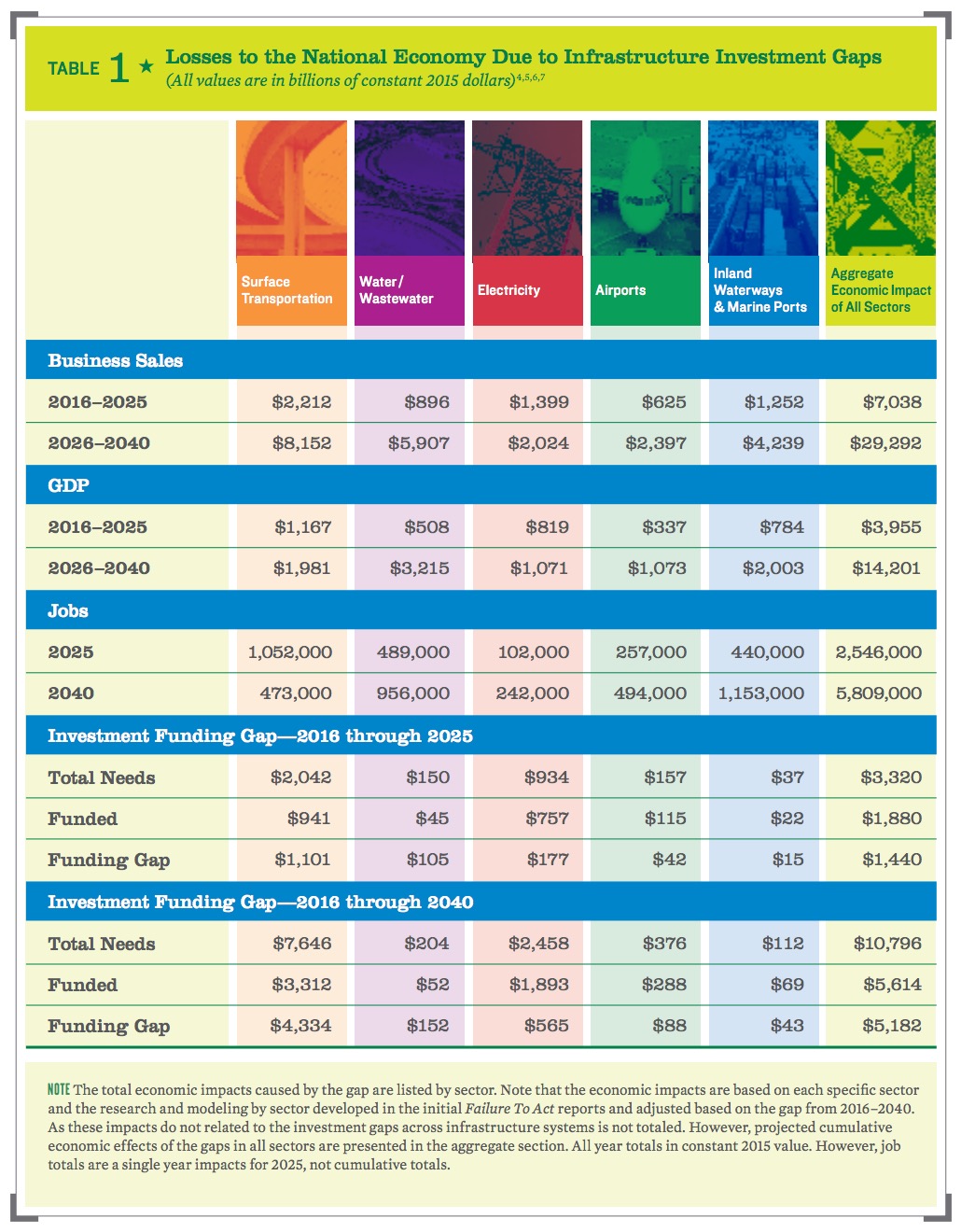AMERICAN SOCIETY OF CIVIL ENGINEERS (ASCE)
The report is the latest in a series of Failure to Act studies, launched in 2011, that assesses how the nation’s failure to improve its infrastructure systems affects economic performance.
Executive Summary
Infrastructure is the backbone of the U.S. economy and a necessary input to every economic output. It is critical to every nation’s prosperity and the public’s health and welfare. Each Failure to Act study demonstrates that deteriorating infrastructure, long known to be a public safety issue, has a cascading impact on our nation’s economy, impacting business productivity, gross domestic product (GDP), employment, personal income, and international competitiveness.
The economic stakes of America’s infrastructure systems are high because its condition can either help or hurt the productivity of the economy. Poor infrastructure affects business productivity as well as every sector and region of the U.S. because when one part of the infrastructure system fails, the impact can spread throughout the system and economy. The U.S. economy relies on low transportation costs and the reliable delivery of clean water and electricity to businesses and households to offset higher wage levels and costs.
Failure to Act shows that business costs and, therefore, prices will increase if surface transportation systems worsen, ports, airports and inland waterways become outdated or congested, and if water, wastewater and electricity infrastructure systems deteriorate or fail to keep up with changing demand. Greater costs to transport the wide array of imported goods that supply domestic manufacturers and rising costs for exports will affect our ability to compete in global markets for goods produced in the U.S. Irregular delivery of water and wastewater services and electricity will make production processes more expensive and divert household disposable income to these basic necessities. Increased reliance on electricity to support modern data-driven systems and industries is particularly important when the cost of service outages and interruptions is considered.
The cost of deteriorating infrastructure takes a toll on families’ disposable household income and impacts the quality and quantity of jobs in the U.S. economy. With deteriorating infrastructure, higher business costs will be incurred in terms of charges for services and efficiency, which will lead to higher costs incurred by households for goods and services due to the rising prices passed on by businesses. For example, travel times will lengthen with inefficient roadways and congested airports and airspace, and out-of-pocket expenditures to households and business costs will rise if the electricity grid or water delivery systems fail to keep up with demand. Goods will be more expensive to produce and more expensive to transport to retail shelves for households or to business customers. Business-related travel, as well as commuting and personal travel, will also become more expensive and less reliable. As a consequence, U.S. businesses will be more inefficient. As costs rise, business productivity falls, causing GDP to drop, cutting employment, and ultimately reducing personal income. The result of these effects will be a reduction of disposable income and reduced spending for consumer goods and services, which will further exacerbate business impacts. From 2016 to 2025, each household will lose $3,400 each year in disposable income due to infrastructure deficiencies; and if not addressed, the loss will grow to an average of $5,100 annually from 2026 to 2040, resulting in cumulative losses up to almost $34,000 per household from 2016 to 2025 and almost $111,000 from 2016 to 2040 (all dollars in 2015 value).
Over time, these impacts will also affect businesses’ ability to provide well-paying jobs, further reducing incomes. If this investment gap is not addressed throughout the nation’s infrastructure sectors by 2025, the economy is expected to lose almost $4 trillion in GDP, resulting in a loss of 2.5 million jobs in 2025.
Moreover, workers who are employed will earn lower wages, and in the long term, many higher paying jobs in technology and other leading sectors will be replaced by jobs that fulfill needs brought on by the inefficiencies of deteriorating infrastructure.
Closing each infrastructure investment gap is possible, and the economic consequences caused by these gaps are avoidable with investment. The economic analysis of this report indicates that our nation’s inland waterways and marine ports, electricity infrastructure, airports, as well as water and wastewater infrastructure have all shown some modest improvement or been stable since the previous reports. However, this is not the case with for the surface transportation investment gap which has increased since the prior studies. While the physical condition of America’s road pavement and bridge structures has improved, roadway congestion continues to increase over time, and the condition of America’s public transportation facilities and equipment continues to decline. While some of the infrastructure investment gap are showing modest signs of improvement, and the overall U.S. investment funding gap is still quite substantial, and the negative economic consequences of insufficient investment continue to be a significant drag on economic productivity. With the failure to close the infrastructure investment gap, the economic consequences will grow as well.
Download full version (PDF): Closing the Infrastructure Investment Gap for America’s Economic Future
About the American Society of Civil Engineers (ASCE)
www.asce.org
The American Society of Civil Engineers represents more than 150,000 members of the civil engineering profession in 177 countries. Founded in 1852, ASCE is the nation’s oldest engineering society. ASCE stands at the forefront of a profession that plans, designs, constructs, and operates society’s economic and social engine – the built environment – while protecting and restoring the natural environment.
Tags: American Society of Civil Engineers, ASCE, Failure to Act







 RSS Feed
RSS Feed